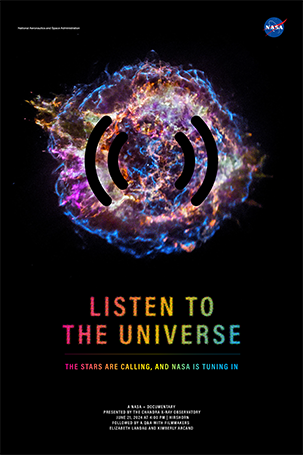Isaacman Visit to Chandra Operations Control Center
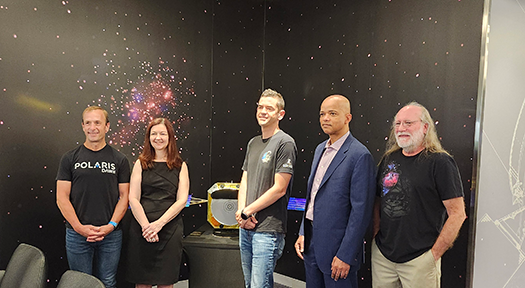
From left to right: Scott “Kidd” Poteet, Lisa Kewley, Jared Isaacman, Bob Curbeam, Pat Slane
Credit: NASA/CXC/SAO/J.McDowell
Last June, the Chandra X-ray Center had the privilege of welcoming Commander Jared Isaacman to our Operations Control Center (OCC). This facility is Chandra’s “mission control” where engineers and scientists communicate with the telescope and receive its invaluable data.
Exoplanets Need to be Prepared for Extreme Space Weather, Chandra Finds
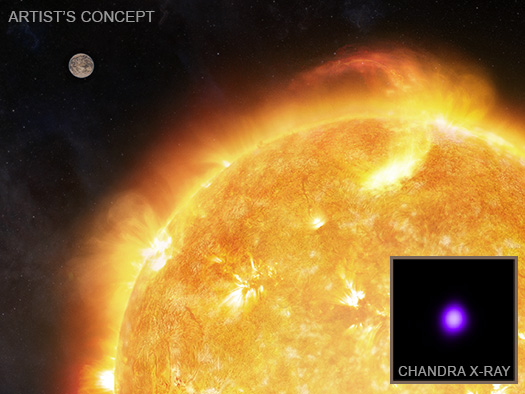
Illustration of Wolf 359 with Chandra X-ray Inset
Credit: X-ray: NASA/CXC/SAO/S.Wolk, et al.; Illustration: NASA/CXC/SAO/M.Weiss; Image processing: NASA/CXC/SAO/N. Wolk
This artist’s illustration represents the results from a new study that examines the effects of X-ray and other high-energy radiation unleashed on potential exoplanets from a host star. As outlined in our latest press release, astronomers using NASA’s Chandra X-ray Observatory and ESA’s XMM-Newton observed Wolf 359, a red dwarf that is only 7.8 light-years from Earth, making it one of the closest stars to the Earth other than the Sun.
The artist’s rendering shows Wolf 359 in the foreground and a potential planet in orbit around it in the background. Red dwarfs are the most common type of star in the Universe. They are much smaller and dimmer than Sun-like stars, which allows them to last for trillions of years. This would give planets in orbit around them ample time for life to form and emerge, which makes them particularly interesting to scientists looking for life beyond the Solar System.
X-ray Echoes Reveal the 3D Structure of Molecular Clouds in our Galaxy's Center
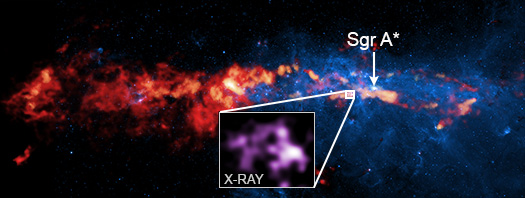
The Center of the Milky Way Galaxy & the Stone Cloud in X-ray Light
Credit: X-ray: NASA/CXC/UConn/D. Alboslani et al.; Infrared: NASA/ESA/JPL/CalTech/Herschel; NASA/ESA/JPL/CalTech/Spitzer; Radio: ASIAA/SAO/SMA; Image Processing: NASA/CXC/SAO/N. Wolk
This image represents a study using decades of data to learn about the 3D structure of molecular clouds in the center of the Milky Way. The panorama in this graphic contains radio data from the Submillimeter Array (green), and infrared from the Herschel Space Telescope (red), and the Spitzer Space Telescope (blue). The inset shows the X-ray data from a molecular cloud from NASA’s Chandra X-ray Observatory.
NASA Missions Spot Cosmic 'Wreath' Displaying Stellar Circle of Life
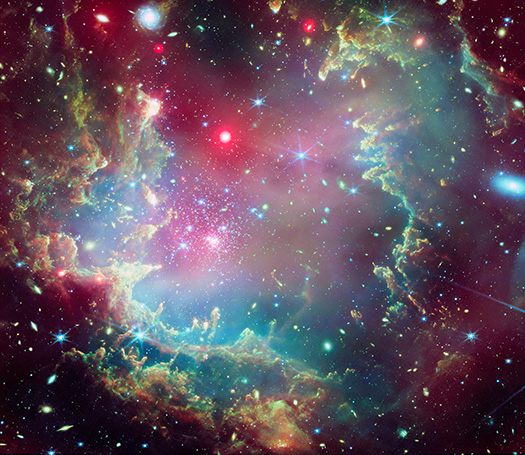
NGC 602
Credit: X-ray: NASA/CXC; Infrared: ESA/Webb, NASA & CSA, P. Zeilder, E.Sabbi, A. Nota, M. Zamani;
Image Processing: NASA/CXC/SAO/L. Frattare and K. Arcand
Since antiquity, wreaths have symbolized the cycle of life, death, and rebirth. It is fitting then that one of the best places for astronomers to learn more about the stellar lifecycle resembles a giant holiday wreath itself.
The star cluster NGC 602 lies on the outskirts of the Small Magellanic Cloud, which is one of the closest galaxies to the Milky Way, about 200,000 light-years from Earth. The stars in NGC 602 have fewer heavier elements compared to the Sun and most of the rest of the galaxy. Instead, the conditions within NGC 602 mimic those for stars found billions of years ago when the universe was much younger.
New Performance Helps Connect Science Through Music

Agnes Coakley Cox, soprano, sings in "Luminosity"
Credit: David Ibbett, Center for Astrophysics | Harvard & Smithsonian (CfA)
A new composition, performed live for the first time on December 14th at the Black Hole Symphony at the Christine McAuliffe Center, is helping people discover science through music.
David Ibbett is Resident Composer at the Center for Astrophysics | Harvard & Smithsonian (CfA), Professor of Music at Worcester Polytechnic Institute, and the Director of Multiverse Concert Series. His new “Voice of the Universe” project uses music to shed light on astrophysical data and images.
The first song to be released, entitled “Luminosity,” was created from the image SMACS 0723 made from data from NASA’s Chandra X-ray Observatory and James Webb Space Telescope. Different parts of the image are sonified in different ways. Sonification is the process of translating astronomical data into sound using scientific and mathematical mapping. This allows humans to engage with data from the cosmos using one of their senses other than sight.
Chandra Sees Black Hole Jet Stumble Into Something in the Dark
Even matter ejected by black holes can run into objects in the dark. Using NASA’s Chandra X-ray Observatory, astronomers have found an unusual mark from a giant black hole’s powerful jet striking an unidentified object in its path.
The discovery was made in a galaxy called Centaurus A (Cen A), located about 12 million light-years from Earth. Astronomers have long studied Cen A because it has a supermassive black hole in its center sending out spectacular jets that stretch out across the entire galaxy. The black hole launches this jet of high-energy particles not from inside the black hole, but from intense gravitational and magnetic fields around it.
NASA's Chandra, Hubble Tune Into 'Flame-Throwing' Guitar Nebula
Your browser does not support the video tag.
Pulsar B2224+65 and the “Guitar Nebula”
Credit: X-ray: NASA/CXC/Stanford Univ./M. de Vries et al.; Optical: (Hubble) NASA/ESA/STScI and (Palomar) Hale Telescope/Palomar/CalTech; Image Processing: NASA/CXC/SAO/L. Frattare
Normally found only in heavy metal bands or certain post-apocalyptic films, a “flame-throwing guitar” has now been spotted moving through space. Astronomers have captured movies of this extreme cosmic object using NASA’s Chandra X-ray Observatory and Hubble Space Telescope.
The new movie of Chandra (red) and Palomar (blue) data helps break down what is playing out in the Guitar Nebula. X-rays from Chandra show a filament of energetic matter and antimatter particles, about two light-years or 12 trillion miles long, blasting away from the pulsar (seen as the bright white dot connected to the filament).
"Above and Beyond" Celebrates Chandra and CfA at the Hirshhorn
A symphonic event at the Smithsonian’s Hirshhorn Museum and Sculpture Garden on November 16th 2024 provided a remarkable opportunity to celebrate 25 years with the Chandra X-ray Observatory on the Mall in Washington, D.C. The free program, entitled "Above and Beyond," was built around Chandra’s milestone anniversary and featured the premiere of "Where Parallel Lines Converge." This original piece by composer Sophie Kastner, created with Chandra and alongside CXC experts, was inspired by the Chandra sonifications of the Galactic Center region. The ensemble musicians were from the 21st Century Consort and their performance was outstanding. In addition to the music, there was a selection of space imagery/video that helped showcase Chandra science. Dr. Kimberly Arcand of the Center for Astrophysics | Harvard & Smithsonian (CfA) was on hand for a special conductor’s discussion and question-and-answer session before the performance along with other invited guests, and there was a brief reception afterwards.
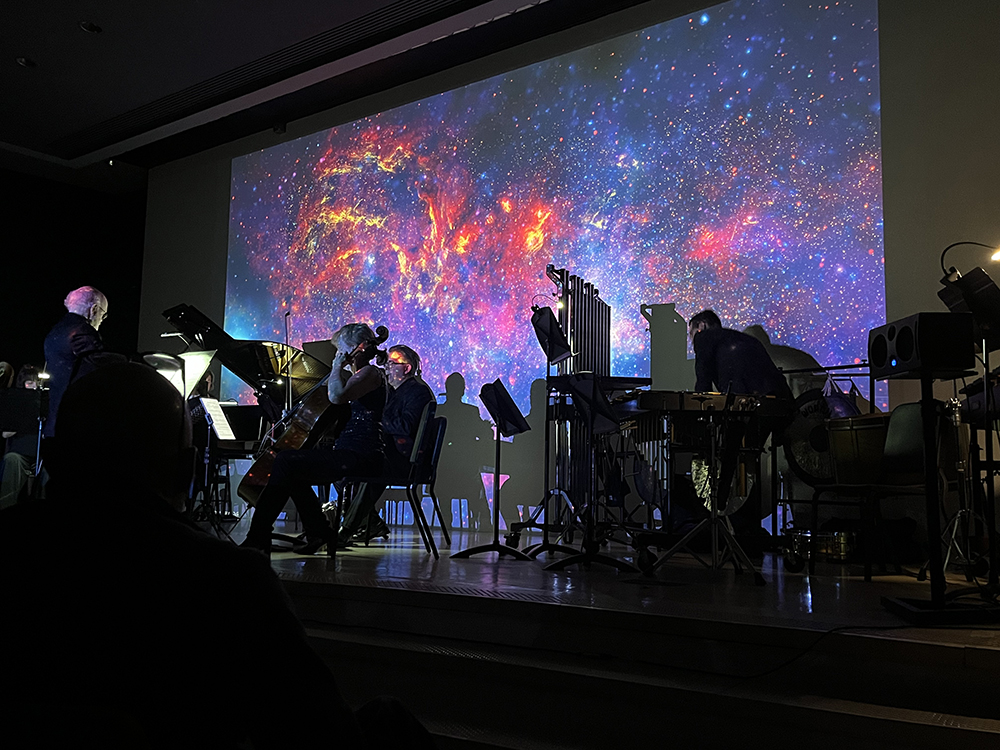
Planets Beware: NASA Unburies Danger Zones of Star Cluster

Cyg OB2
Credit: X-ray: NASA/CXC/SAO/J. Drake et al, IR: NASA/JPL-Caltech/Spitzer;
Image Processing: NASA/CXC/SAO/N. Wolk
Most stars form in collections, called clusters or associations, that include very massive stars. These giant stars send out large amounts of high-energy radiation, which can disrupt relatively fragile disks of dust and gas that are in the process of coalescing to form new planets.
A team of astronomers used NASA’s Chandra X-ray Observatory, in combination with ultraviolet, optical, and infrared data, to show where some of the most treacherous places in a star cluster may be, where planets’ chances to form are diminished.
The target of the observations was Cygnus OB2, which is the nearest large cluster of stars to our Sun — at a distance of about 4,600 light-years. The cluster contains hundreds of massive stars as well as thousands of lower-mass stars. The team used long Chandra observations pointing at different regions of Cygnus OB2, and the resulting set of images were then stitched together into one large image.
Chandra Documentary Wins Award in Film Festival

Images from the Raw Science Film Festival Awards Ceremony, featuring
Matthew Modine, Dr. Kim Arcand, Elizabeth Landau, and more.
On Saturday, October 5, the Raw Science Film Festival opened in New York City and the CfA’s Dr. Kimberly Arcand was on hand, along with Elizabeth Landau of NASA HQ, to celebrate the “Listen to the Universe” documentary that won the Industry award for “Best New Media”.
“Listen to the Universe” is a 20-minute documentary produced by the Chandra X-ray Center at the CfA and NASA+ that takes viewers behind the scenes of the team that creates data sonifications.
The Raw Science Film Festival included an awards ceremony featuring a special Q&A with actor/executive producer Matthew Modine, along with screenings and director discussions of "Listen to the Universe" and other selected films. The festival's overall mission is to humanize science and keep fact-based storytelling at the forefront of popular culture.
-Megan Watzke CXC


